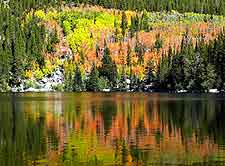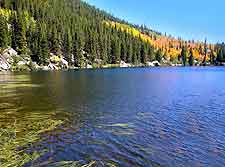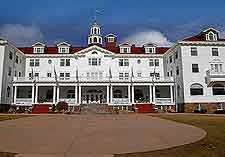Estes Park History Facts and Timeline
(Estes Park, Colorado - CO, USA)

Estes Park is among Colorado's most important holiday destinations. Even before local history really began, European explorers started visiting the area, while native indigenous tribes, including Ute and Arapaho people, would regularly spend their summer months in this region.
Trails of the indigenous populations, which lead from Estes Park across the continental divide to the Grande Lake region, can be explored within the Rocky Mountain National Park today, the entrance of which is situated less than 2 miles / 3 km from the center.
Gold Rush and Settlement
Despite explorers and adventurers flocking to the region in the early 1800s, Estes Park wasn't actually settled until the Colorado gold rush began in 1859. Mining mostly occurred to the south of present day Estes Park, but a wealthy Kentuckian miner named Joel Estes saw potential in the current site at this time.
By 1860, he moved his family to the area and founded the settlement. During the same period in Estes Park history, the settlement was named after William Byers, editor of the Rocky Mountain News, who visited in area in 1864. Estes, struggling to develop his cattle ranch, sold it to Welshman Griffith Evans who began a 'dude ranch' on the land in the late 1860s

In the 1870s, one of the first successful cattle ranches was established here and the MacGregor Ranch is still operating on its original site today. There is a museum located within the ranch, providing information about the history of ranching in Estes Park in addition to exhibits of the original owner, Alexander McGregor.
Tourism in the Early 20th Century
The Earl of Dunraven came to Estes Park as a guest of Evans in 1903 and fell in love with the place. He eventually bought the whole valley, wanting to turn it into a hunting and resort region for tourists.
The Elkhorn Lodge was built in the late 19th century and the luxurious Stanley Hotel was established in 1909. This same hotel can still be visited today, or even stayed at for a high price. The close proximity of the Rocky Mountain National Park and its stunning scenery made Estes Park a popular tourist destination following the turn of the century.

Despite large cattle ranches operating within Estes Park, tourism became the major source of income for the town, and this has been the case throughout the 20th and the early part of the 21st century, with the resort town attracting the likes of Pope John Paul II spent and the Emperor of Japan.
The Gutsiest Town in Colorado
In 1982, Estes Park was almost demolished by a flood, after the manmade Lawn Lake Dam in the nearby national park faulted. However, the town quickly rebuilt itself and now carries the title of the 'Gutsiest Little Town in Colorado'.
Today, more than three million tourists base themselves in Estes Park en route to the Rocky Mountain National Park each year. The interesting history of the town can be further explored at the Estes Park Museum on 4th Street.
 Estes Park is among Colorado's most important holiday destinations. Even before local history really began, European explorers started visiting the area, while native indigenous tribes, including Ute and Arapaho people, would regularly spend their summer months in this region.
Estes Park is among Colorado's most important holiday destinations. Even before local history really began, European explorers started visiting the area, while native indigenous tribes, including Ute and Arapaho people, would regularly spend their summer months in this region.
